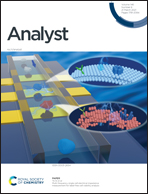Orange emissive carbon nanodots for fluorescent and colorimetric bimodal discrimination of Cu2+ and pH†
Abstract
We have facilely synthesized orange emissive carbon nanodots (O-CDs) via a hydrothermal method using citric acid and 5-aminosalicylic acid. The obtained O-CDs show the excellent characteristics of excitation independence, low toxicity, fabulous photostability and superior biocompatibility. Based on these captivating properties, as-prepared O-CDs have been successfully implemented as a multi-functional sensing platform for fluorescent and colorimetric bimodal recognition of Cu2+ and pH. Upon adding Cu2+, the orange fluorescence of the O-CDs is evidently quenched with a linear range of 0 μM–300 μM, and a detection limit of 28 nM. Additionally, as the pH increases from 7.0 to 10.2, the O-CDs manifest an obvious decrease in orange fluorescence, which shows a pKa value of 8.73 and excellent linearity in the pH range of 8.0–9.2. Appealingly, the laser confocal imaging of O-CD-stained cells demonstrates that the fluctuations of Cu2+ and pH can be visualized in living cells.



 Please wait while we load your content...
Please wait while we load your content...